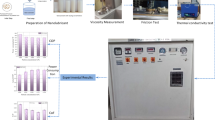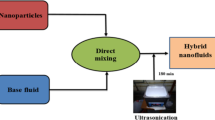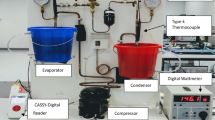Abstract
The present work is aimed to reduce the compressor load in a domestic air conditioning system, by introducing a shell-and-coil type heat exchanger as an intercooler. The intercooler uses initially a binary mixture of ethylene glycol:water at 30:70 ratio as a shell-side base fluid and later uses nanofluids with Al2O3 nanoparticles of different volume concentrations. The coefficient of performance (COP) of the system was estimated at different shell-side fluid flow rates of 1, 1.5 and 2 LPM. COP was found to increase with the decrease in the refrigerant temperature at the compressor inlet, due to the reduction in the compressor work input. A highest increment in the COP of around 31 % was observed for the base fluid and 49.32 % was observed for the 0.75 % nanofluid with a flow rate of 2 LPM compared with the case without intercooler. An appreciable reduction in power consumption of 12.24 % was also observed.
Similar content being viewed by others
Abbreviations
- COP:
-
Coefficient of performance
- NF:
-
Nanofluid
- BF:
-
Base Fluid
- IC:
-
Intercooler
- SC-HEX:
-
Shell-and-coil heat exchanger
- I:
-
Electric current
- m ref :
-
Mass flow rate, kg/s
- LPM:
-
Liter per minute
- c:
-
Compressor
- p:
-
Pump
- f:
-
Fan
- ref:
-
Refrigerant
- 1:
-
Compressor inlet
- 2:
-
Compressor outlet
- 3:
-
Intercooler outlet
- 4:
-
Condenser outlet
- 5:
-
Evaporator inlet
References
Hu S.S., Huang B.J.: Study of a high efficiency residential water-cooled air conditioner. Int. J. Refrig. 25, 1599–1613 (2005)
Dalkilic A.S., Kurekci N.A., Kincay O., Wongwises S.: Fundamental basis and application of cold-room project design: a turkish case study. Arab. J. Sci. Eng. 38, 1115–1130 (2013)
Ahamed J.U., Saidur R., Masjuki H.H.: Investigation of environmental and heat transfer analysis of air conditioner using hydrocarbon mixture compared to R-22. Arab. J. Sci. Eng. 39, 4141–4150 (2014)
Hwang Y., Radermacher R., Kopoko W.: An experimental evaluation of a residential-sized evaporatively cooled condenser. Int. J Refrig. 24, 238–249 (2001)
Lee W.L., Chen H., Yik F.W.H.: Modeling the performance characteristics of water-cooled air-conditioners. Energy Build. 40, 1456–1465 (2008)
Avara A., Daneshgar E.: Optimum placement of condensing units of split-type air-conditioners by numerical simulation. Energy Build. 40, 1268–1272 (2008)
Xiaowen Y., Lee W.L.: The use of helical heat exchanger for heat recovery domestic water-cooled air conditioners. Energy Conserv. Manag. 50, 240–246 (2009)
Manna R., Jayakumar J.S., Grover R.B.: Thermal hydraulic design of a condenser for a natural circulation system. J Energy Heat Mass Transf. 18, 39–46 (1996)
Jayakumar, J.S.; Grover, R.B.: Two phase natural circulation residual heat removal. In: Proceedings of 3rd ISHMT-ASME Heat and Mass Transfer Conference, Kanpur, India (1997)
Prabhanjan D.G., Rennie T.J., Raghavan G.S.V.: Natural convection heat transfer from helical coiled tubes. Int. J. Therm. Sci. 43(4), 359–365 (2004)
Wu Z., Yang F., Zhang Z., Bao Z.: Magnesium based metal hydride reactor incorporating helical coil heat exchanger: simulation study and optimal design. Appl. Energy 130, 712–722 (2014)
Award M.M., Mustafa H.M., Sultan G.I., Elbooz A., Elghonemy A.M.K.: Performance enhancement of air-cooled condensers. Acta Polytech. Hung. 1(2), 125–142 (2007)
Ling J., Hwang Y., Radermacher R.: Theoretical study on separate sensible and latent cooling air-conditioning system. Int. J. Refrig. 33, 510–520 (2010)
Amori K.E.: Thermal and hydraulic characteristics of a novel helical coiled tube used as a heat exchanger. Arab. J. Sci. Eng. 39(5), 4179–4186 (2014)
Leong K.Y., Saidur R., Kazi S.N., Mamun A.H.: Performance investigation of an automotive car radiator operated with nanofluid-based coolants (nanofluid as a coolant in a radiator). Appl. Therm. Eng. 30, 2685–2692 (2010)
Mare T., Halefadl S., Sow O., Estelle P., Duret S., Bazantay F.: Comparison of the thermal performances of two nanofluids at low temperature in a plate heat exchanger. Exp. Therm. Fluid Sci. 35, 1535–1543 (2011)
Peyghambarzadeh S.M., Hashemabadi S.H., Hoseini S.M., Jamnani M.S.: Experimental study of heat transfer enhancement using water/ethylene glycol based nanofluids as a new coolant for car radiators. Int. Commun. Heat Mass Transf. 38, 1283–1290 (2011)
Loaiza, J.C.V.; Pruzaesky, F.C.; Parise, J.A.R.: A numerical study on the application of nanofluids in refrigeration systems, paper 1145. In: Proceedings of International Refrigeration and Air Conditioning Conference, Purdue (2010)
Moukalled F., Verma S., Darwish M.: The use of CFD for predicting and optimizing the performance of air conditioning equipment. Int. J. Heat Mass Transf. 54, 549–563 (2011)
Sheikholeslami M., Gorji-Bandpy M., Ganji D.D.: Investigation of Nanofluid Flow and Heat Transfer in Presence of Magnetic Field Using KKL Model. Arab. J. Sci. Eng. 39(6), 5007–5016 (2014)
Balaji N., Kumar P.S.M.: Effect of water with anti-freezing material based cooling for split air conditioning system. Appl. Mech. Mater. 404, 432–435 (2013)
Hajidavalloo E.: Application of evaporative cooling on the condenser of window air-conditioner. Appl. Therm. Eng. 27, 1937–1943 (2007)
Ruan B., Jacobi A.M.: Ultrasonication effects on thermal and rheological properties of carbon nanotube suspensions. Nanoscale Res. Lett. 7:127, 1–14 (2012)
Scherrer P.: Bestimmung der Grösse und der inneren Struktur von Kolloidteilchen mittels Röntgenstrahlen. Nachr. Ges. Wiss. Göttingen 26, 98–100 (1918)
Raveshi M.R., Keshavarz A., Mojarrad M.S., Amiri S.: Experimental investigation of pool boiling heat transfer enhancement of alumina–water–ethylene glycol nanofluids. Exp. Therm. Fluid Sci. 44, 805–814 (2013)
Holman J.P.: Experimental Methods for Engineers, Seventh Ed. Tata McGraw-Hill Publishing Company Limited, New Delhi (2007)
Hajidavalloo E., Eghtedari H.: Performance improvement of air-cooled refrigeration system by using evaporatively cooled air condenser. Int. J. Refrig. 33, 982–988 (2010)
Author information
Authors and Affiliations
Corresponding author
Rights and permissions
About this article
Cite this article
Balaji, N., Kumar, P.S.M., Velraj, R. et al. Experimental Investigations on the Improvement of an Air Conditioning System with a Nanofluid-Based Intercooler. Arab J Sci Eng 40, 1681–1693 (2015). https://doi.org/10.1007/s13369-015-1644-7
Received:
Accepted:
Published:
Issue Date:
DOI: https://doi.org/10.1007/s13369-015-1644-7




